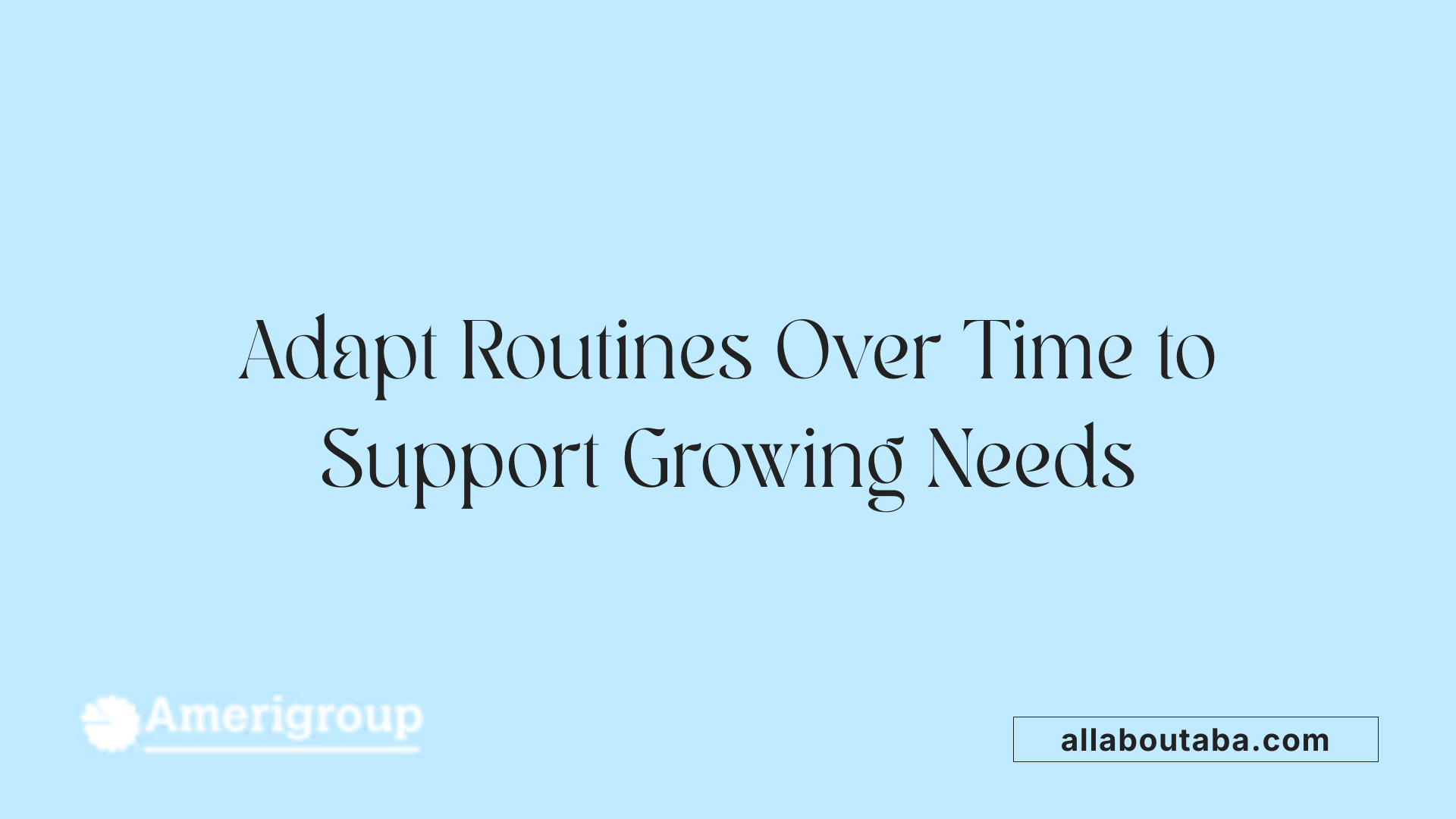Best Ways To Build Daily Routines For Autistic Children
Importance of Structured Daily Routines for Autistic Children
Establishing effective daily routines is crucial for supporting the development, well-being, and independence of children on the autism spectrum. Routines provide predictability, reduce anxiety, and foster skills necessary for social engagement and daily living. This article explores best practices and proven strategies to build personalized routines that cater to each child's unique needs, ensuring a balanced and nurturing environment.
Understanding the Power of Routine Stability
Why are structured routines important in supporting the development and well-being of autistic children?
Structured routines play a crucial role in helping children with autism feel safe and secure in their daily lives. These routines provide a predictable environment that reduces feelings of uncertainty and stress, which are common challenges faced by autistic children.
When routines are consistent, children can better understand what to expect, making transitions between activities smoother and less stressful. Visual supports like schedules, pictures, and social stories are effective tools that help children grasp the sequence of daily events, encouraging independence and enhancing communication skills.
Creating a stable routine environment also enables caregivers and teachers to plan activities more effectively, leading to improved behavioral outcomes. As children become familiar with their routines, they tend to show increased engagement, social interaction, and emotional regulation.
Furthermore, routines offer meaningful opportunities for learning, whether it's practicing self-care, developing social skills, or completing household chores. Gradually introducing flexibility within routines fosters adaptability, helping children manage change over time.
In summary, routines are not just about organization—they are foundational to supporting children with autism in achieving developmental goals, reducing anxiety, and fostering a nurturing environment for growth.
Designing Effective Daily Routines

Steps to identify key daily activities and tasks
Creating a structured routine starts by recognizing all of the important activities in your child's day. This typically includes waking up, meals, playtime, outdoor activities, naps, and bedtime. Each activity should be relevant to the child's daily needs and tailored to their specific schedule and environment.
Next, break these activities into smaller, manageable tasks. For example, morning routines might include waking up, brushing teeth, getting dressed, and having breakfast. Listing all these steps helps make routines clear and achievable.
Breaking routines into manageable steps with visual aids
Using visual supports like pictures, symbols, or written words can significantly help your child understand and anticipate what comes next. Visual schedules with photos of each step enable children to grasp the sequence of events, reducing confusion and stress.
Timers and countdowns serve as visual cues that signal upcoming transitions. This approach prepares children for change, helping them feel more secure.
Additionally, laminating images can make visual aids durable for daily use. Regular practice with these visual schedules encourages independence and confidence.
Personalizing routines based on individual preferences and needs
Every child with autism has unique preferences, sensitivities, and strengths. Personalizing routines involves observing what activities your child enjoys and incorporating these into their daily schedule. When routines include favored activities, children are more motivated to engage.
Involving your child in creating their routine fosters a sense of ownership and cooperation. You can also adapt routines as your child's needs evolve by seeking feedback and making necessary adjustments.
Implementing positive reinforcement, such as praise and rewards, when your child successfully follows their routine can boost motivation and promote consistency.
In summary, effective routines are built on understanding your child's daily needs, breaking tasks into smaller steps aided by visual supports, and customizing routines to make them enjoyable and manageable. Consistent implementation, with flexibility and positive reinforcement, supports your child's independence and emotional well-being.
Amplifying Routine Success with Visual Supports
 Creating visual schedules with photos, symbols, or words is a highly effective way to support children with autism in following daily routines. These visual tools provide a clear, accessible representation of activities such as waking up, meal times, or bedtime, helping children understand what to expect next. By incorporating familiar images or simple text, visual schedules make routines more concrete and less overwhelming, especially for children who may miss social cues or find transitions challenging.
Creating visual schedules with photos, symbols, or words is a highly effective way to support children with autism in following daily routines. These visual tools provide a clear, accessible representation of activities such as waking up, meal times, or bedtime, helping children understand what to expect next. By incorporating familiar images or simple text, visual schedules make routines more concrete and less overwhelming, especially for children who may miss social cues or find transitions challenging.
Using laminated visual aids enhances their durability, allowing them to withstand everyday handling and repeated use. Laminating protects the visuals from spills, tears, and general wear and tear, ensuring that they remain available as a reliable resource throughout the day. This durability encourages consistent use, reinforcing routine stability.
Involving children in creating these visuals can boost their motivation to follow routines. When children participate in making or selecting images, they develop a sense of ownership and increase their engagement. For example, they can help choose pictures that represent their favorite activities or preferred tasks, making routines more appealing and personalized.
How can visual schedules and tools support routine adherence in autistic children?
Visual schedules and tools serve as personalized roadmaps that make daily routines tangible. They help children predict upcoming activities, thereby reducing anxiety and helping them transition smoothly between tasks. These visual aids support independence by enabling children to understand sequences without always needing adult prompts. As a result, children can develop self-regulation, focus, and confidence, making routines more manageable and less stressful for everyone involved.
Consistency and Reinforcement in Routine Building
Why Is Maintaining Regular Timings for Activities Important?
Consistency in timing, such as setting fixed times for waking up, meals, free play, and bedtime, plays a vital role in helping children with autism feel secure and supported. Predictable schedules reduce the anxiety that often comes with unexpected changes, making daily transitions smoother.
Especially for children with autism, establishing anchor points around regular activities anchors their day and offers a sense of familiarity. A stable routine allows children to anticipate what’s next, easing stress and fostering independence.
How Do Timers, Countdowns, and Positive Reinforcement Help?
Using visual timers and countdowns prepares children for upcoming transitions, helping them understand when changes are about to happen. This visual anticipation minimizes confusion and distress.
Positive reinforcement methods, such as praise, rewards, or engaging in preferred activities, motivate children to participate in routines willingly. Celebrating small successes boosts confidence and encourages ongoing cooperation.
Combining timers and positive feedback creates a supportive environment where children learn to manage transitions and develop new skills gradually.
How Does Gradually Introducing Flexibility Benefit Children?
While structure is important, flexibility can be slowly introduced to help children adapt better to changes. Small adjustments, supported by visual cues or timers, allow children to grow comfortable with variation in their routines.
Practicing flexibility without overwhelming them supports emotional regulation and builds resilience. Over time, children learn that change is manageable, reducing resistance or anxiety.
Overall, consistent timing paired with positive reinforcement forms a foundation for trust and security. Gradual flexibility fosters adaptability and independence, helping children navigate daily routines confidently.
Addressing Common Challenges Through Routine Strategies
 Supporting children with autism in managing communication, anxiety, behavior, eating, sleeping, and socializing issues requires thoughtful routines that are consistent yet flexible.
Supporting children with autism in managing communication, anxiety, behavior, eating, sleeping, and socializing issues requires thoughtful routines that are consistent yet flexible.
Establishing clear, predictable daily schedules helps children understand what to expect, creating a sense of stability and security. Visual supports such as picture schedules, social stories, and visual cues aid comprehension and reduce confusion. Timers and countdowns serve as effective tools for preparing children for transitions, minimizing distress and helping them develop patience.
To address anxiety and behavioral challenges, routines should incorporate calming activities and safe spaces like sensory-friendly calm-down corners. Preparing children for changes gradually and rewarding flexible responses build resilience over time. Including preferred activities within daily routines increases engagement and positive reinforcement.
Managing eating and sleep routines is also vital. Consistent meal and bedtime schedules help regulate health and routine adherence. Using visual aids to guide self-care routines and establishing a soothing environment in bedrooms can promote better sleep. Regular health check-ups ensure ongoing support for health issues.
By continuously reviewing and adjusting routines based on feedback, caregivers can meet each child's individual needs. This dynamic approach fosters independence, enhances social communication, and supports overall emotional well-being, making routines a powerful tool for overcoming common challenges faced by children with autism.
Supporting Independent Skill Development

How can parents and caregivers design and implement personalized routines for autistic children?
Creating effective routines tailored to an individual child's needs involves several practical strategies and resources. Parents and caregivers can start by consulting behavioral specialists, who often provide personalized plans that focus on the child's strengths and sensitivities. Support groups are also valuable as they share experiences and helpful tips.
Visual supports are widely recommended and include visual schedules with photographs, symbols, or written words that illustrate daily tasks. These can be laminated for durability and made colorful to attract the child's attention. Using Velcro or other removable attachments allows routines to be easily adjusted as the child's needs evolve.
Involving the child in planning routines fosters a sense of ownership and motivation. Positive reinforcement, like praise or small rewards, encourages adherence and fosters confidence. Establishing predictable schedules for wake-up, meals, play, and bedtime offers a sense of security, reducing anxiety around transitions.
Timers and countdowns are valuable tools that prepare children for upcoming changes, helping them to manage transitions smoothly. Sensory-friendly spaces, such as a calm-down corner equipped with sensory items, provide a safe haven during overloads.
Regular reviews and adjustments ensure routines remain effective and align with the child's development. Tailoring routines based on individual preferences and strengths enhances the child's engagement and independence.
For further support, parents can search for resources like “resources for creating routines for autism,” which provide detailed guides and community advice.
How is visual support used to foster independence?
Visual supports like checklists and visual routines help break down complex tasks into manageable steps. This clarity encourages children to try tasks independently, from self-care to household chores. For example, checklists for dressing or grooming can include simple pictures and words, guiding the child through each step.
Gradually introducing these supports builds confidence. As children master skills, visual aids can be phased out or simplified, fostering greater self-reliance.
Why is gradual skill building important?
Fostering independence involves teaching life skills incrementally. Starting with simple, achievable tasks encourages success, which builds motivation. Consistent practice in real-life settings ensures skills are meaningful and applicable. Over time, children learn to navigate daily routines, make choices, and participate meaningfully in their communities.
By supporting children to learn at their own pace, and providing necessary visual tools and encouragement, parents and caregivers help them develop independence that benefits all aspects of life—home, school, and beyond.
Fostering Growth and Adaptability in Daily Routines

How can routines be adapted over time to meet evolving needs of autistic children?
Adapting routines for children with autism is an ongoing process that ensures their changing needs are met effectively. Regular review and open communication with the child and caregivers are crucial. Observing how the child responds to current routines helps identify what works and what needs adjustment.
Gradually introducing flexibility into structured routines allows children to develop resilience and adaptability. This can involve slight modifications to daily activities or the timing of tasks, supported by visual aids and timers.
Involving the child in routine planning encourages a sense of ownership and independence. For example, allowing them to choose between two activities or helping set the schedule can increase motivation and cooperation.
It’s important to celebrate successes and be attentive to signs of stress or overwhelm. When a routine no longer fits the child's needs, small, manageable changes can be made to better align with their current interests and sensitivities.
By continuously assessing progress and being responsive, routines can evolve as the child grows. This approach promotes skill development, reduces anxiety related to change, and helps children navigate different stages of their development more confidently.
Creating a Supportive Environment for Growth
Developing and maintaining effective daily routines for autistic children is a dynamic process that requires patience, observation, and collaboration. Utilizing visual supports, consistent schedules, positive reinforcement, and flexibility ensures routines are tailored to each child's strengths and needs. Regular review and adaptation help foster independence, reduce stress, and promote social and emotional development. By creating a predictable, structured environment, caregivers and educators lay the foundation for children's success, confidence, and well-being.
References
- Tips to Create a Routine for a Child with Autism
- Create A Schedule For An Autistic Child: A Complete Guide
- 10 Ways To Establish Routines for Children with Autism
- How to help your autistic child with day-to-day life
- Life skills for autism
- Tips to Create a Routine for a Child with Autism
- Create A Schedule For An Autistic Child: A Complete Guide
- How to help your autistic child with day-to-day life
Other articles
Recent articles

Cultural Perspectives On Autism Around The World

Autism And Creative Arts As Emotional Expression Tools

Developing Emotional Regulation Skills In Autistic Teens

Best Sensory-Friendly Lighting Solutions For Autism

Cognitive Behavioral Therapy Adaptations For Autism

Best Practices For Autism-Friendly Movie Screenings

Autism And Eating Challenges Beyond Picky Eating

Best Practices For Autism-Friendly Public Transport Design

Best Ways To Foster Collaboration Between Parents And Schools For Autism Support

Supporting Autistic Children During Transitions Between Activities

The Role Of Teachers In Fostering Autism Peer Acceptance

Using Art Therapy To Support Children With Autism

Autism And Strategies For Addressing Sensory Defensiveness

Autism And The Benefits Of Structured Leisure Activities

How To Support Autistic Students During Exam Season

Autism And Goal Setting For Personal Growth

How To Use Gamification In Autism Learning Programs

How Schools Can Reduce Bullying Of Autistic Students

Early Intervention Strategies For Autism Spectrum Disorder

The Role Of Therapists In Autism Life Skills Coaching

How To Support Autistic Individuals In Crisis Situations

Autism And Self-Care Routines For Stress Management

Understanding Echolalia And Its Role In Autism Communication

Autism And Fine Arts Education Benefits

The Impact Of Multisensory Learning On Autism Education

How Family Counseling Supports Autism Household Dynamics

Best Practices For Inclusive Playgrounds For Autism

Best Practices For Autism-Friendly Shopping Centers

How Autism Affects Fine Motor Skill Development

Best Ways To Introduce Sensory Activities Into Daily Routines

How Sports Teams Can Be Inclusive Of Autistic Players

Autism And Strategies For Building Workplace Resilience

Autism And The Impact Of Hormonal Changes During Puberty

How To Support Autistic Students In Foreign Language Classes

Best Ways To Teach Money Skills To Teens With Autism

Supporting Siblings Of Children With Autism

Autism And Co-Occurring Gastrointestinal Disorders

The Role Of Art Projects In Autism Sensory Integration

How Schools Can Incorporate Sensory Break Spaces

Best Practices For Autism Sensory Regulation At School

Autism And Strategies For Teaching Organizational Skills

Understanding The Relationship Between Autism And Anxiety Disorders

Autism And Life Planning For Long-Term Care

Exploring Visual Supports In Autism Education

Ways To Encourage Social Interaction In Children With Autism

The Connection Between Autism And Dyscalculia

The Role Of Occupational Therapy In Transition Planning For Autism

The Role Of Physical Therapists In Autism Motor Skills Support

How To Teach Decision-Making Skills To Autistic Young Adults

The Connection Between Autism And Epilepsy

Best Practices For Transitioning Autistic Children Into New Schools

Autism And Time Management Challenges In Adulthood

The Role Of Visual Arts In Autism Communication Development

How To Address Tactile Defensiveness In Autism

Best Practices For Telehealth Autism Therapy

How To Help Autistic Children Develop Friendship Skills

How Schools Can Support Autistic Students In Career Prep

Best Strategies For Autism-Friendly Event Planning

Understanding Noncontingent Reinforcement In Autism Behavior Plans

How Drama Therapy Benefits Autistic Individuals

Best Practices For Autism-Friendly Fitness And Recreation Centers

Best Ways To Promote Healthy Social Media Use For Autistic Teens

How To Help Autistic Children Cope With Public Speaking

Autism And Strategies For Managing Unexpected Changes

Best Podcasts About Autism For Parents And Educators

Autism And The Impact Of Seasonal Changes On Behavior

The Role Of Diet In Managing Co-Occurring Conditions With Autism

Sleep Challenges In Autism And Practical Solutions

Best Ways To Build Daily Routines For Autistic Children

Best Practices For Supporting Autistic Entrepreneurs

Autism And Strategies For Navigating Large Social Gatherings

Adaptive Sports And Recreational Activities For People With Autism

Autism And The Benefits Of Story-Based Learning Activities

Understanding The Role Of Play In Autism Development

Autism And The Impact Of Environmental Noise On Learning

How To Create Autism-Friendly Community Spaces

Autism And Chronic Health Conditions: What To Know

The Role Of Care Managers In Autism Life Planning

How To Teach Social Boundaries To Autistic Children

How Autistic Individuals Experience Empathy Differently

How To Support Autistic Employees In Remote Work Settings

Autism And The Relationship Between Motor Skills And Learning

How To Create Community Resource Guides For Autism Families

How To Teach Daily Living Skills To Autistic Teens

Autism And The Impact Of Mind-Body Practices On Stress Reduction

Autism And The Benefits Of Outdoor Group Activities

How To Create Autism-Friendly Sensory Paths In Schools

Best Practices For Autism-Friendly Park And Recreation Areas

Autism And Strategies For Reducing School Refusal

Supporting Autistic Individuals In Public Speaking

The Role Of Diet In Managing Autism Symptoms

The Benefits Of Gardening Clubs For Autism Social Development

How To Prepare Autistic Children For Dental Visits

Autism And Employment: Career Paths That Work

Best Practices For Autism-Friendly Hotels And Lodging

The Impact Of Screen Time On Autism Development

Autism Screening Tools For Early Childhood

The Role Of Physical Exercise In Autism Therapy

Best Strategies For Supporting Autistic College Students

The Role Of Technology In Autism Early Detection
We’re All About You, Your Family, and Your Child

